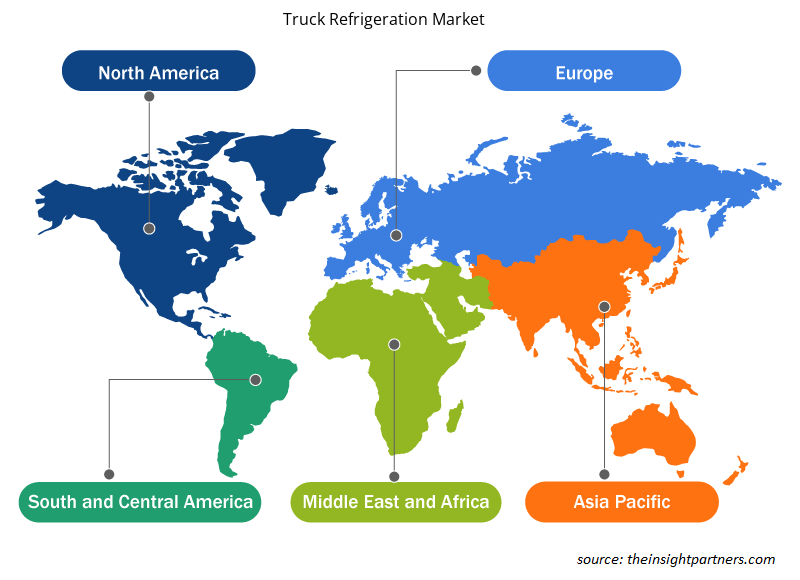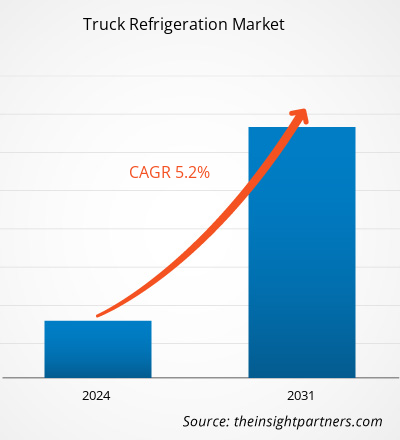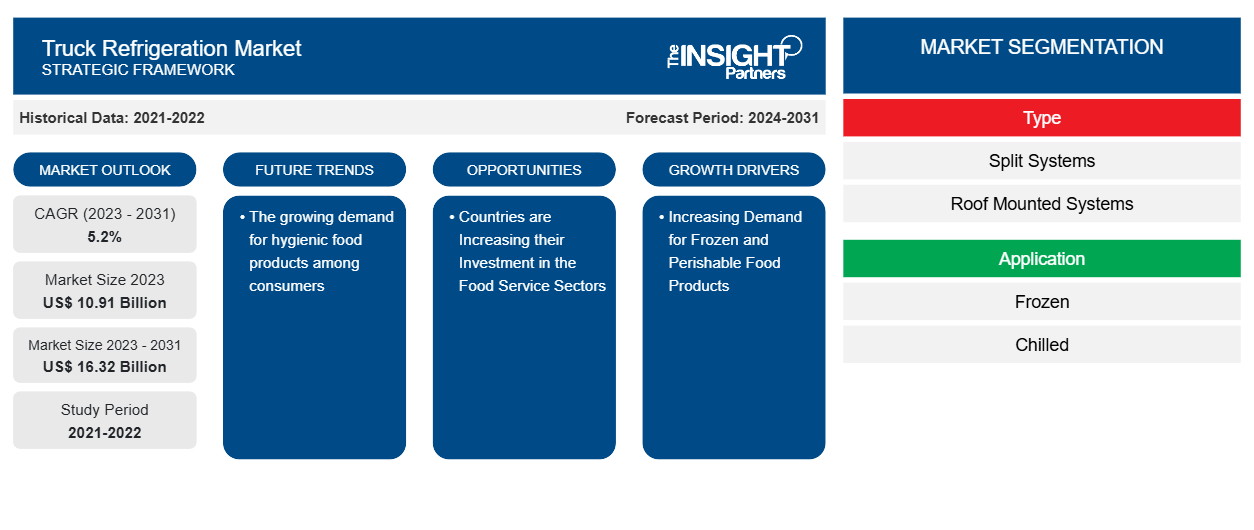Si prevede che la dimensione del mercato della refrigerazione per autocarri raggiungerà i 16,32 miliardi di dollari entro il 2031, rispetto ai 10,91 miliardi di dollari del 2023. Si prevede che il mercato registrerà un CAGR del 5,2% nel 2023-2031. La crescente domanda di prodotti alimentari igienici tra i consumatori rimarrà probabilmente una tendenza chiave del mercato della refrigerazione per autocarri.
Analisi del mercato della refrigerazione dei camion
Il mercato della refrigerazione per autocarri sta crescendo a un ritmo rapido a causa della crescente domanda di prodotti alimentari congelati e deperibili e dell'espansione di supermercati e ristoranti come Subways, Domino e KFC, tra gli altri. Il mercato si sta espandendo costantemente, guidato dall'attenzione del produttore nel ridurre gli sprechi durante il trasporto dei prodotti. Inoltre, i paesi stanno aumentando i loro investimenti nei settori della ristorazione e la crescente domanda di sistemi avanzati di controllo e monitoraggio della temperatura nei camion sta offrendo opportunità redditizie per la crescita del mercato.
Panoramica del mercato della refrigerazione per camion
La refrigerazione per camion si riferisce ai sistemi installati nei camion per mantenere temperature specifiche per il trasporto di vari articoli deperibili, tra cui cibo, prodotti chimici e farmaceutici. Questi sistemi utilizzano unità di refrigerazione alimentate dal motore di un camion o da fonti di energia indipendenti. I notevoli vantaggi offerti dalla refrigerazione per camion agli utenti stanno alimentando il mercato durante il periodo di previsione. Questi sistemi sono utilizzati per mantenere una temperatura ottimale e preservare la qualità e la sicurezza degli articoli durante il trasporto aumentando la durata di conservazione del prodotto e riducendo gli sprechi.
Personalizza questo report in base alle tue esigenze
Riceverai la personalizzazione gratuita di qualsiasi report, comprese parti di questo report, o analisi a livello nazionale, pacchetto dati Excel, oltre a usufruire di grandi offerte e sconti per start-up e università
- Scopri le principali tendenze di mercato in questo rapporto.Questo campione GRATUITO includerà analisi di dati che spaziano dalle tendenze di mercato alle stime e alle previsioni.
Driver e opportunità del mercato della refrigerazione per camion
La crescente domanda di prodotti alimentari surgelati e deperibili sta guidando il mercato
L'aumento del consumo di prodotti alimentari congelati, refrigerati e deperibili alimenterà il mercato globale dei camion refrigerati nel prossimo futuro. I cambiamenti negli stili di vita e nelle abitudini alimentari dei consumatori, così come i loro ritmi frenetici, stanno facendo aumentare la domanda di prodotti alimentari refrigerati, confezionati e congelati. Inoltre, il mercato è guidato dalla necessità di trasportare una varietà di prodotti alimentari con diversi requisiti di temperatura contemporaneamente. Questi camion aiutano a mantenere il cibo sicuro e fresco durante il trasporto. I camion sono dotati di apparecchiature di refrigerazione che mantengono il cibo fresco e sicuro. Questi camion trasportano cibo e bevande fresche dagli stabilimenti di produzione ai magazzini e ai punti di distribuzione. Inoltre, l'aumento del reddito disponibile porta a un aumento del consumo di cibi pronti. Tuttavia, un aumento del numero di ristoranti e supermercati, che crea una domanda favorevole per i camion refrigerati, sta stimolando il mercato.
I paesi stanno aumentando i loro investimenti nel settore della ristorazione: un’opportunità nel mercato della refrigerazione per camion
Paesi come Cina e India stanno aumentando i loro investimenti nei settori della ristorazione, il che dovrebbe creare opportunità nel mercato globale della refrigerazione per autocarri. L'elevata importanza del settore agroindustriale nei paesi emergenti come India, Cina, Brasile e altri aumenta la domanda di refrigerazione per autocarri per la conservazione dei prodotti agricoli. Questi paesi stanno investendo molto nel settore della ristorazione espandendo la logistica della catena del freddo , portando a una maggiore domanda di autocarri refrigerati, il che dovrebbe creare significative opportunità di crescita nel mercato durante il periodo di previsione.
Analisi della segmentazione del rapporto di mercato sulla refrigerazione dei camion
I segmenti chiave che hanno contribuito alla derivazione dell'analisi del mercato della refrigerazione per autocarri sono tipologia, applicazione, settore verticale e tipo di veicolo.
- In base al tipo, il mercato della refrigerazione per camion è suddiviso in sistemi split e sistemi montati sul tetto. Il segmento montato sul tetto ha detenuto una quota di mercato maggiore nel 2023.
- Sulla base dell'applicazione, il mercato è segmentato in congelato e refrigerato. Il segmento congelato ha detenuto una quota di mercato maggiore nel 2023.
- In base alla verticale, il mercato della refrigerazione per camion è segmentato in food & beverage, farmaceutico e chimico e ambulanza. Il segmento food & beverage ha detenuto una quota di mercato maggiore nel 2023.
- In termini di tipologia di veicolo, il mercato è categorizzato come rimorchi e veicoli commerciali medi e pesanti. Il segmento dei rimorchi ha detenuto una quota di mercato maggiore nel 2023.
Analisi della quota di mercato della refrigerazione dei camion per area geografica
L'ambito geografico del rapporto sul mercato della refrigerazione per autocarri è suddiviso principalmente in cinque regioni: Nord America, Asia Pacifico, Europa, Medio Oriente e Africa e Sud America/Sud e Centro America.
In termini di fatturato, l'Asia Pacifica ha rappresentato la quota di mercato più grande per la refrigerazione dei camion, a causa dell'elevato consumo di prodotti congelati e refrigerati. Stili di vita in evoluzione, aumento della spesa dei consumatori e crescente domanda di praticità, tra le altre cose, stanno aumentando la domanda di cibo congelato, verdure fresche e snack, che a loro volta stanno guidando il mercato della refrigerazione dei camion durante il periodo di previsione. Inoltre, la presenza di importanti attori, tra cui Daikin Industries, Ltd., Denso Corporation e Sanden, tra gli altri, sta creando opportunità nel mercato. Questi attori sono impegnati nello sviluppo di camion innovativi per fornire ai propri clienti una soluzione migliore, dando impulso al mercato.
Approfondimenti regionali sul mercato della refrigerazione per autocarri
Le tendenze regionali e i fattori che influenzano il Truck Refrigeration Market durante il periodo di previsione sono stati ampiamente spiegati dagli analisti di Insight Partners. Questa sezione discute anche i segmenti e la geografia del Truck Refrigeration Market in Nord America, Europa, Asia Pacifico, Medio Oriente e Africa e Sud e Centro America.

- Ottieni i dati specifici regionali per il mercato della refrigerazione dei camion
Ambito del rapporto sul mercato della refrigerazione dei camion
| Attributo del report | Dettagli |
|---|---|
| Dimensioni del mercato nel 2023 | 10,91 miliardi di dollari USA |
| Dimensioni del mercato entro il 2031 | 16,32 miliardi di dollari USA |
| CAGR globale (2023-2031) | 5,2% |
| Dati storici | 2021-2022 |
| Periodo di previsione | 2024-2031 |
| Segmenti coperti | Per tipo
|
| Regioni e Paesi coperti | America del Nord
|
| Leader di mercato e profili aziendali chiave |
|
Densità degli operatori del mercato della refrigerazione per autocarri: comprendere il suo impatto sulle dinamiche aziendali
Il mercato della refrigerazione per autocarri sta crescendo rapidamente, spinto dalla crescente domanda degli utenti finali dovuta a fattori quali l'evoluzione delle preferenze dei consumatori, i progressi tecnologici e una maggiore consapevolezza dei vantaggi del prodotto. Con l'aumento della domanda, le aziende stanno ampliando le loro offerte, innovando per soddisfare le esigenze dei consumatori e capitalizzando sulle tendenze emergenti, il che alimenta ulteriormente la crescita del mercato.
La densità degli operatori di mercato si riferisce alla distribuzione di aziende o società che operano in un particolare mercato o settore. Indica quanti concorrenti (operatori di mercato) sono presenti in un dato spazio di mercato in relazione alle sue dimensioni o al valore di mercato totale.
Le principali aziende che operano nel mercato della refrigerazione per camion sono:
- Società globale di trasporto
- Azienda produttrice di componenti per motori Daikin Industries, Ltd. Industries, Ltd.
- Società Denso Corporation
- Società Klinge Corporation
- Mitsubishi Heavy Industries, Ltd.
- SCHMITZ CARGOBULL
Disclaimer : le aziende elencate sopra non sono classificate secondo un ordine particolare.

- Ottieni una panoramica dei principali attori del mercato della refrigerazione per camion
Notizie e sviluppi recenti sul mercato della refrigerazione dei camion
Il mercato della refrigerazione per autocarri viene valutato raccogliendo dati qualitativi e quantitativi dopo la ricerca primaria e secondaria, che include importanti pubblicazioni aziendali, dati associativi e database. Di seguito è riportato un elenco degli sviluppi nel mercato della refrigerazione per autocarri e delle strategie:
- A novembre 2023, Daikin Industries, Ltd. ha presentato le sue ultime soluzioni per la refrigerazione in furgoni, camion e rimorchi a SOLUTRANS, l'hub globale per veicoli commerciali pesanti e leggeri. La gamma di prodotti completamente elettrici e ibridi plug-in di Daikin riduce le emissioni dei motori a combustione interna. Il produttore globale presenta le sue innovazioni per la refrigerazione dei trasporti, tra cui la sua nuova unità di refrigerazione per rimorchi, Exigo, insieme alla nuova piattaforma di connettività Daikin Telematics. (Fonte: Daikin Industries, Ltd., comunicato stampa, 2023)
Copertura e risultati del rapporto sul mercato della refrigerazione per camion
Il rapporto "Dimensioni e previsioni del mercato della refrigerazione per camion (2021-2031)" fornisce un'analisi dettagliata del mercato che copre le seguenti aree:
- Dimensioni e previsioni del mercato a livello globale, regionale e nazionale per tutti i segmenti di mercato chiave coperti dall'ambito
- Dinamiche di mercato come fattori trainanti, vincoli e opportunità chiave
- Principali tendenze future
- Analisi dettagliata delle cinque forze PEST/Porter e SWOT
- Analisi di mercato globale e regionale che copre le principali tendenze di mercato, i principali attori, le normative e gli sviluppi recenti del mercato
- Analisi del panorama industriale e della concorrenza che copre la concentrazione del mercato, l'analisi della mappa di calore, i principali attori e gli sviluppi recenti
- Profili aziendali dettagliati
- Analisi storica (2 anni), anno base, previsione (7 anni) con CAGR
- Analisi PEST e SWOT
- Valore/volume delle dimensioni del mercato - Globale, Regionale, Nazionale
- Industria e panorama competitivo
- Set di dati Excel
Report recenti
Rapporti correlati
Testimonianze
Motivo dell'acquisto
- Processo decisionale informato
- Comprensione delle dinamiche di mercato
- Analisi competitiva
- Analisi dei clienti
- Previsioni di mercato
- Mitigazione del rischio
- Pianificazione strategica
- Giustificazione degli investimenti
- Identificazione dei mercati emergenti
- Miglioramento delle strategie di marketing
- Aumento dell'efficienza operativa
- Allineamento alle tendenze normative





















 Ottieni un campione gratuito per - Mercato della refrigerazione per camion
Ottieni un campione gratuito per - Mercato della refrigerazione per camion